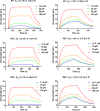Screening and evaluation of anti-SARS-CoV-2 components from Ephedra sinica by ACE2/CMC-HPLC-IT-TOF-MS approach
- PMID: 33608752
- PMCID: PMC7895511
- DOI: 10.1007/s00216-021-03233-7
Screening and evaluation of anti-SARS-CoV-2 components from Ephedra sinica by ACE2/CMC-HPLC-IT-TOF-MS approach
Abstract
Traditional Chinese medicines played an important role in the treatment of COVID-19 in 2020. Ephedra sinica, one of the major constituent herbs of multi-component herbal formula, has been widely used to treat COVID-19 in China. However, its active components are still unclear. The objectives of this study are to screen and evaluate active components from the traditional Chinese medicine Ephedra sinica for the treatment of COVID-19. In our study, we established an ACE2/CMC bioaffinity chromatography model, and then developed an ACE2/CMC-HPLC-IT-TOF-MS system for the active compounds screening and identification from Ephedra sinica extract. We performed molecular docking and surface plasmon resonance (SPR) assays to assess the binding characteristics (binding mode and KD value). We used CCK-8 staining to assess the toxicity of screened compounds, and also used SARS-CoV-2 pseudovirus to observe the viropexis effect of screened compounds in ACE2h cells. In this current work, one fraction was fished out, separated and identified as ephedrine (EP), pseudoephedrine (PEP), and methylephedrine (MEP). Binding assays showed that the three compounds could bind with ACE2 in a special way to some amino acid residues, similar to the way SARS-CoV-2 bound with ACE2. Additionally, the three compounds, especially EP, can inhibit the entrance of SARS-CoV-2 spike pseudovirus into ACE2h cells because they can reduce the entrance ratio of pseudovirus in the pseudovirus model. Overall, the ACE2/CMC-HPLC-IT-TOF-MS system was established and verified to be suitable for ACE2-targeted bioactive compound screening. EP, PEP, and MEP with ACE2-binding features were screened out from Ephedra sinica, and acted as blockers inhibiting SARS-CoV-2 spike pseudovirus entering ACE2h cells.
Keywords: ACE2 receptor; COVID-19; Cell membrane chromatography; Ephedra sinica.
Conflict of interest statement
The authors declare that they have no conflict of interest. Ethical approval is not applicable. The presented research did not involve humans or animals. Informed consent is not applicable.
Figures







Similar articles
-
Active components in Ephedra sinica stapf disrupt the interaction between ACE2 and SARS-CoV-2 RBD: Potent COVID-19 therapeutic agents.J Ethnopharmacol. 2021 Oct 5;278:114303. doi: 10.1016/j.jep.2021.114303. Epub 2021 Jun 5. J Ethnopharmacol. 2021. PMID: 34102269 Free PMC article.
-
Repositioning of histamine H1 receptor antagonist: Doxepin inhibits viropexis of SARS-CoV-2 Spike pseudovirus by blocking ACE2.Eur J Pharmacol. 2021 Apr 5;896:173897. doi: 10.1016/j.ejphar.2021.173897. Epub 2021 Jan 23. Eur J Pharmacol. 2021. PMID: 33497607 Free PMC article.
-
Biosensor-based active ingredient recognition system for screening potential small molecular Severe acute respiratory syndrome coronavirus 2 entry blockers targeting the spike protein from Rugosa rose.Biomed Chromatogr. 2024 Oct;38(10):e5987. doi: 10.1002/bmc.5987. Epub 2024 Aug 10. Biomed Chromatogr. 2024. PMID: 39126351
-
Inhibition of S-protein RBD and hACE2 Interaction for Control of SARSCoV- 2 Infection (COVID-19).Mini Rev Med Chem. 2021;21(6):689-703. doi: 10.2174/1389557520666201117111259. Mini Rev Med Chem. 2021. PMID: 33208074 Review.
-
Screening S protein - ACE2 blockers from natural products: Strategies and advances in the discovery of potential inhibitors of COVID-19.Eur J Med Chem. 2021 Dec 15;226:113857. doi: 10.1016/j.ejmech.2021.113857. Epub 2021 Oct 4. Eur J Med Chem. 2021. PMID: 34628234 Free PMC article. Review.
Cited by
-
Multicenter, randomized controlled trial of traditional Japanese medicine, kakkonto with shosaikotokakikyosekko, for mild and moderate coronavirus disease patients.Front Pharmacol. 2022 Nov 9;13:1008946. doi: 10.3389/fphar.2022.1008946. eCollection 2022. Front Pharmacol. 2022. PMID: 36438822 Free PMC article.
-
Pseudoephedrine and its derivatives antagonize wild and mutated severe acute respiratory syndrome-CoV-2 viruses through blocking virus invasion and antiinflammatory effect.Phytother Res. 2021 Oct;35(10):5847-5860. doi: 10.1002/ptr.7245. Epub 2021 Sep 1. Phytother Res. 2021. PMID: 34472141 Free PMC article.
-
Application of the Nicoya OpenSPR to Studies of Biomolecular Binding: A Review of the Literature from 2016 to 2022.Sensors (Basel). 2023 May 17;23(10):4831. doi: 10.3390/s23104831. Sensors (Basel). 2023. PMID: 37430747 Free PMC article. Review.
-
Identification of South African Plant-Based Bioactive Compounds as Potential Inhibitors against the SARS-CoV-2 Receptor.Pharmaceuticals (Basel). 2024 Jun 22;17(7):821. doi: 10.3390/ph17070821. Pharmaceuticals (Basel). 2024. PMID: 39065672 Free PMC article.
-
Ephedra alata Subsp. Alenda as a Novel Source of Bioactive Phytochemicals: Characterization Based on the Mass Spectrometry and Profiling of Antioxidant and Anti-Inflammatory Properties.Life (Basel). 2023 Jan 23;13(2):323. doi: 10.3390/life13020323. Life (Basel). 2023. PMID: 36836680 Free PMC article.
References
-
- Cui HT, Li YT, Guo LY, Liu XG, Wang LS, Jia JW, Liao JB, Miao J, Zhang ZY, Wang L, Wang HW, Wen WB. Traditional Chinese medicine for treatment of coronavirus disease 2019: a review. Traditional Med Res. 2020;5(2):65–73.
-
- Chen J, Wang YK, Gao Y, Hu LS, Yang JW, Wang JR, Sun WJ, Liang ZQ, Cao YM, Cao YB. Protection against COVID-19 injury by qingfei paidu decoction via antiviral, anti-inflammatory activity and metabolic programming. Biomed Pharmacother. 2020;129:110281. doi: 10.1016/j.biopha.2020.110281. - DOI - PMC - PubMed
-
- Xu DY, Xu YL, Wang ZW, Lu YL, Zhu HL, Song T. Mechanism of Qingfeipaidu decoction on COVID-19 based on network pharmacology. Pharmacology and Clinics of Chinese Materia Medica. 2020;36(1):26–32.
MeSH terms
Substances
Grants and funding
LinkOut - more resources
Full Text Sources
Other Literature Sources
Miscellaneous

